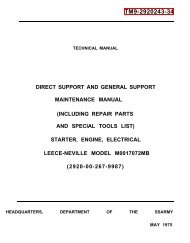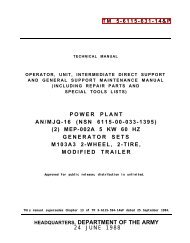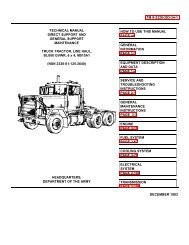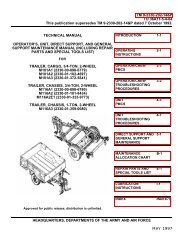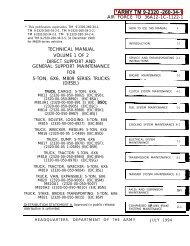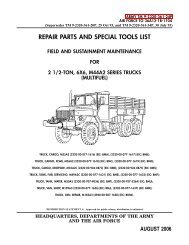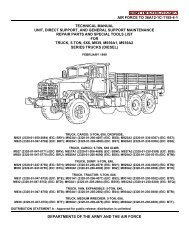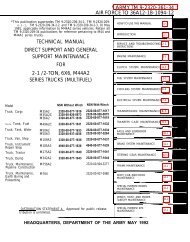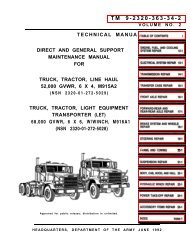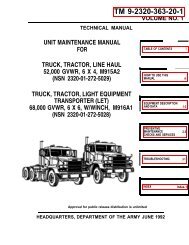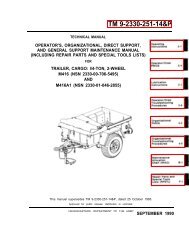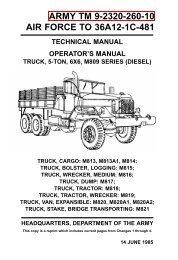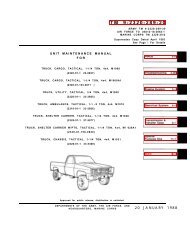TM 9-2320-289-10.pdf
TM 9-2320-289-10.pdf
TM 9-2320-289-10.pdf
You also want an ePaper? Increase the reach of your titles
YUMPU automatically turns print PDFs into web optimized ePapers that Google loves.
1-10. ENGINE<br />
Section III. TECHNICAL PRINCIPLES OF OPERATION<br />
<strong>TM</strong> 9-<strong>2320</strong>-<strong>289</strong>-10<br />
a. The CUCV Series of trucks are powered by a V-8 diesel engine which has a displacement<br />
of 6.2 liters. This engine is similar to a V-8 gasoline engine in many ways, but major differences occur<br />
in cylinder heads, combustion chambers, fuel distribution system, air intake manifold, and method<br />
of ignition.<br />
(1)<br />
(2)<br />
(3)<br />
Fuel Distribution: There is no carburetor on a diesel engine. Instead, fuel is injected<br />
under high pressure through nozzles into the combustion chamber at correct timing<br />
intervals.<br />
Ignition. Ignition of fuel occurs because of heat developed in combustion chamber.<br />
As a result, no spark plugs or high voltage ignition system is required. For cold starts,<br />
glow plugs heat up combustion chamber.<br />
Air Intake Manifold. Air intake manifold is always open to atmospheric pressure. As<br />
a result, the engine does not develop a vacuum supply. Therefore, the engine drives<br />
a vacuum pump which supplies shift signals to the automatic transmission.<br />
b. The lower engine (case, crankshaft, camshaft, bearings, rods, pistons, and wrist pins) is<br />
similar to a gasoline engine, but is of a heavy-duty design because of greater stresses developed<br />
in a diesel engine.<br />
c. Here are some driving tips that will help you maintain good engine performance:<br />
(1)<br />
(2)<br />
(3)<br />
(4)<br />
(5)<br />
(6)<br />
(7)<br />
(8)<br />
(9)<br />
(lo)<br />
1-11. FUEL SYSTEM<br />
DO NOT make full-throttle starts and hard stops.<br />
Take it easy when engine is cold. Maximum performance is reached at normal<br />
operating temperatures.<br />
DO NOT hold truck on an uphill grade with accelerator pedal. Use the regular brakes<br />
to hold truck.<br />
DO NOT use starter aids such as ether or gasoline in air intake system. Such aids can<br />
cause immediate engine damage.<br />
Pumping accelerator pedal before or during cranking will not help start engine.<br />
When engine is cold, let it Idle for a few seconds before driving; this will allow proper<br />
oil pressure to build up. (Increased operating noise and light exhaust smoke are normal<br />
when engine is cold.)<br />
If oil pressure light comes on while operating truck, IMMEDIATELY SHUT DOWN<br />
ENGINE. Continued operation of engine while it is not being properly lubricated will<br />
cause serious damage.<br />
DO NOT use diesel fuel which has been contaminated with engine oils.<br />
Maintain a minimum of 1/4 tank of fuel when temperatures are below 20 0<br />
F.<br />
DO NOT run engine at idle for extended periods of time; damage can occur to engine.<br />
a. A combination of low pressure and high pressure pumping systems moves fuel from the<br />
fuel tank to the engine.<br />
b. Fuel is pumped from the fuel tank by a low pressure pump which moves fuel toward the<br />
fuel filter that separates water and contaminants from the fuel. From the fuel filter, fuel is drawn<br />
into the high pressure injection pump which meters and pressurizes fuel and sends it through high<br />
pressure fuel lines into the injection nozzle located in the engine’s precombustion chamber.<br />
1-13



